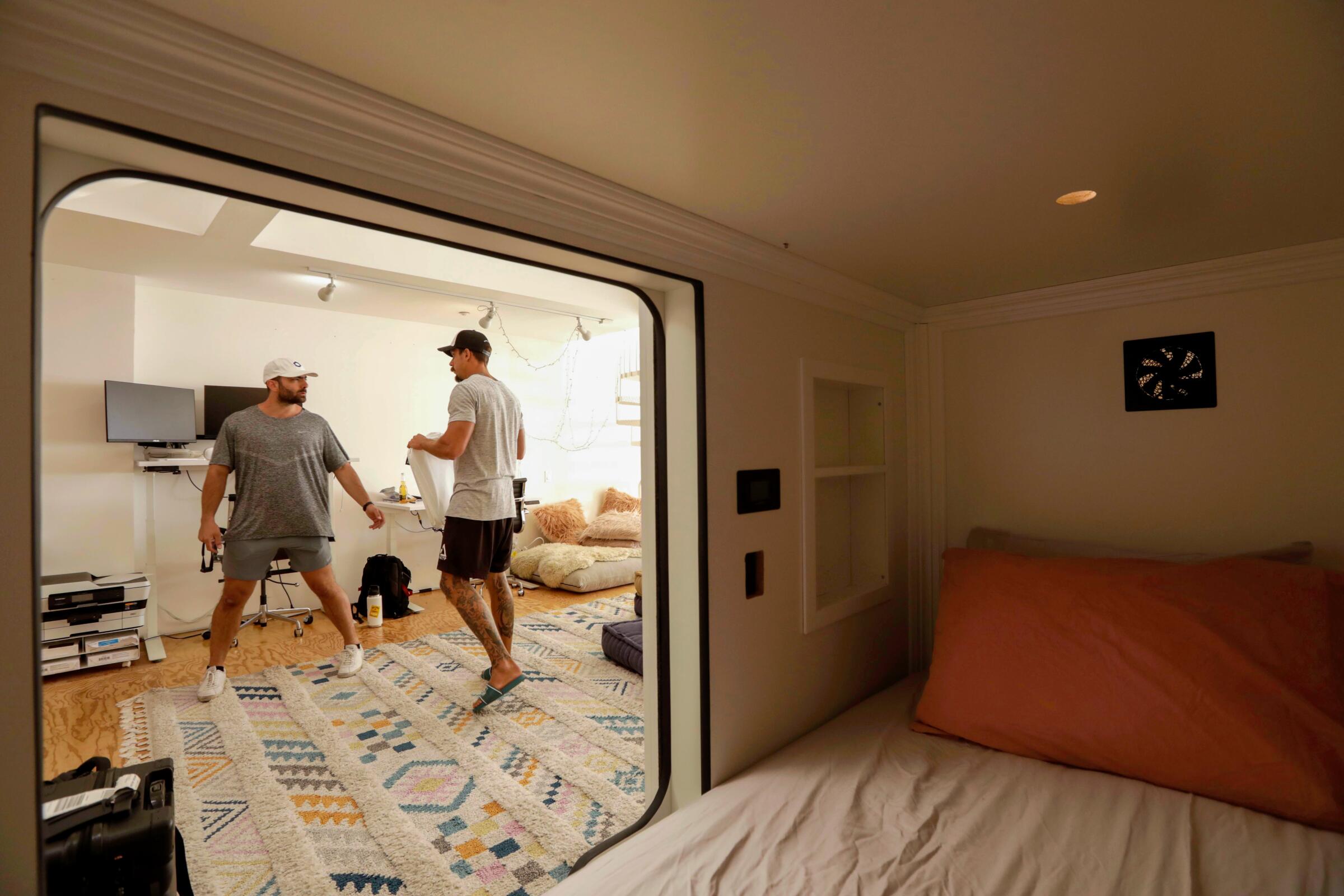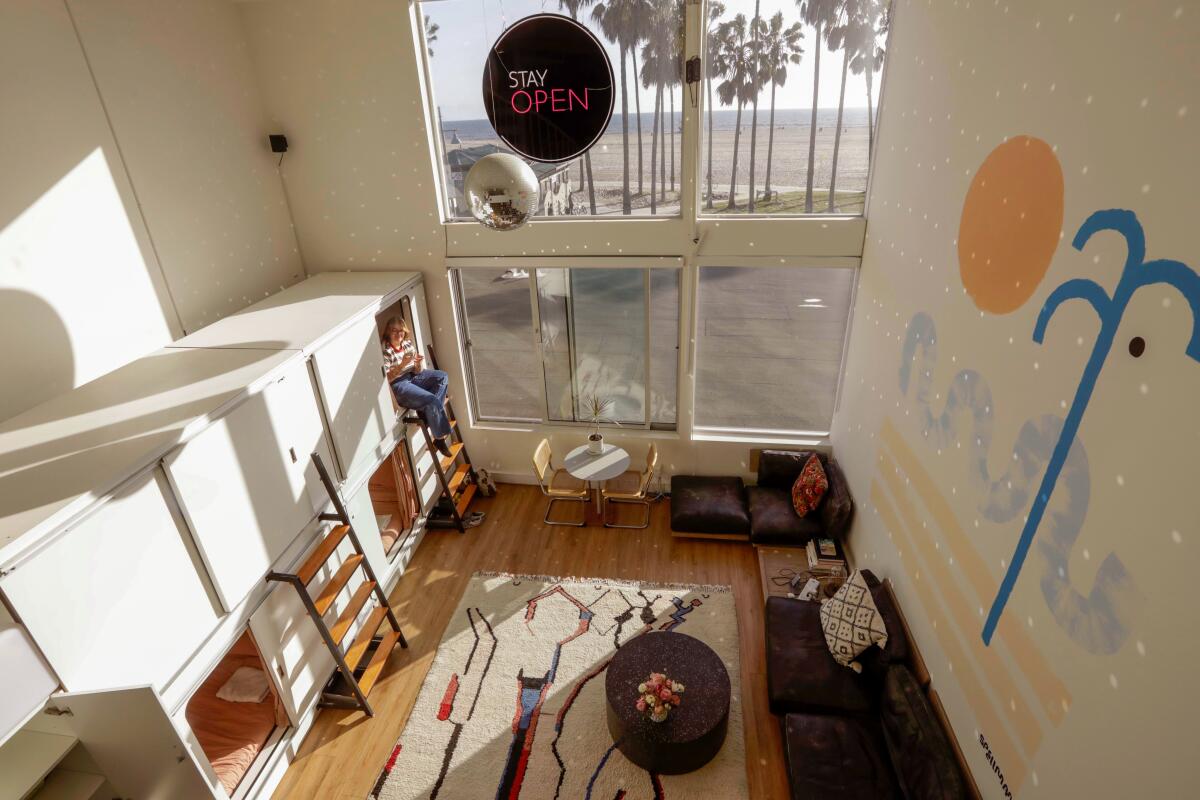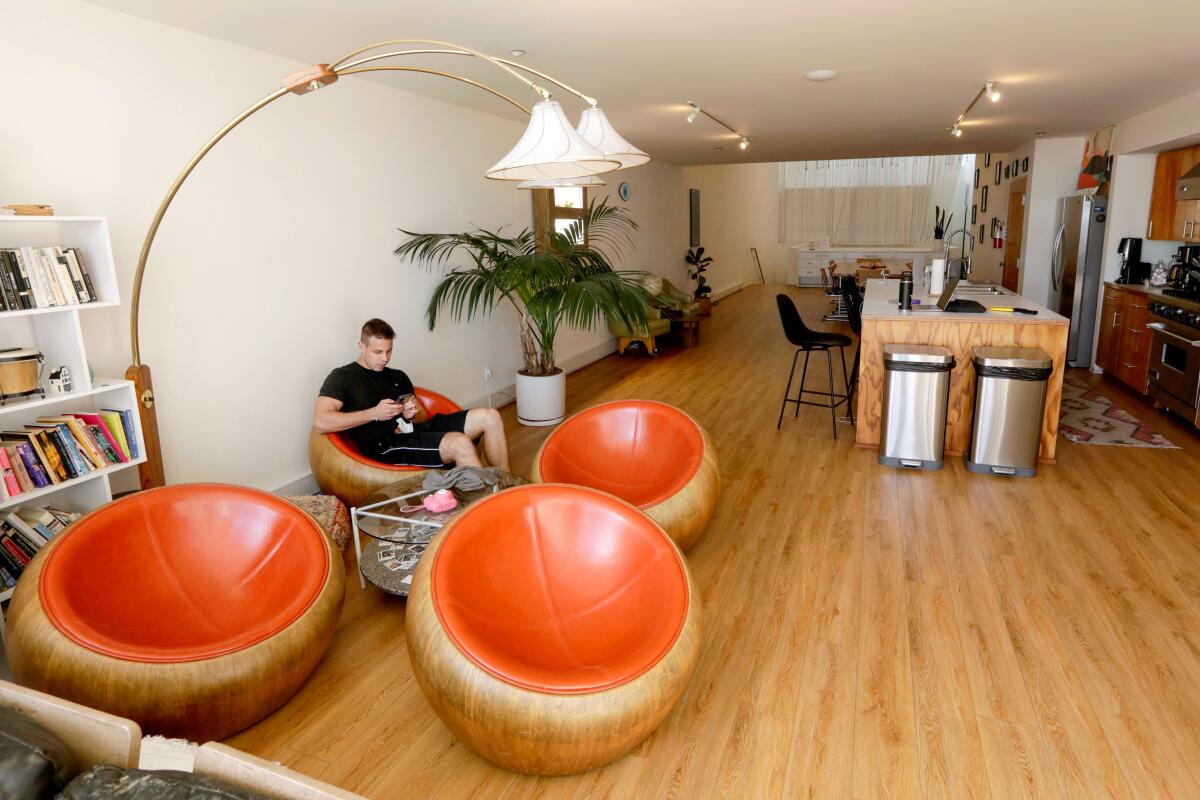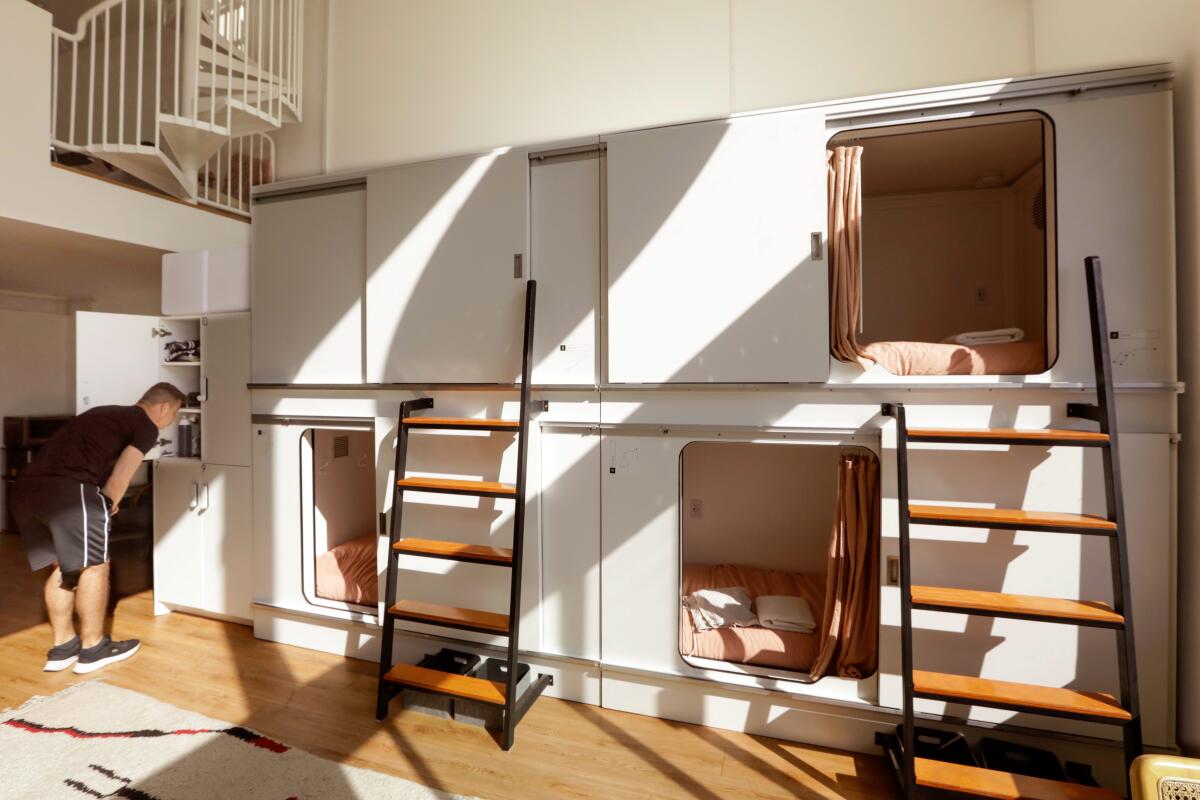Sign up for The Wild
We’ll help you find the best places to hike, bike and run, as well as the perfect silent spots for meditation and yoga.
You may occasionally receive promotional content from the Los Angeles Times.

The last time I slept in a bunk bed, I was 13 years old. (I was at summer camp, where a rude girl in my cabin informed everyone that people can fart in their sleep.) But when I arrived at Stay Open, I still found myself hoping to get a top bunk.
To be clear, the sleeping quarters at Venice’s beachfront pod hotel aren’t exactly bunk beds — rather, they’re refrigerator-sized “pods” stacked atop one another, like giant Lego bricks. Opened in October 2021 in one of the old Snapchat offices, Stay Open is like a more grown-up version of a hostel, blending elements of Japan’s capsule hotels and more recent co-living experiments. The space is bright and modern, with massive windows, millennial pink bedding and a dangling disco ball that’s framed by a prime view of Venice Beach.

Steve Shpilsky, the CEO and co-founder of Stay Open, wants to help change the perception of the hostel, which he says is viewed as “kind of a bad word.”
“You poll the average American, ‘What do you think of a hostel?’ They’re like, ‘Oh, I’m gonna lose a kidney.’ Horror movie. It’s not a great first impression,” he said.
For the record:
10:52 a.m. May 31, 2023An earlier version of this article incorrectly stated that Steve Shpilsky financed and developed the Waldorf Astoria Beverly Hills and the Hyatt Regency. Shpilsky financed, but did not develop, the Waldorf. He also financed and developed the LAX Hyatt House/Place, not the Hyatt Regency.
Shpilsky, 45, worked in traditional hospitality for years — financing the Waldorf Astoria Beverly Hills and one of the Hyatts near LAX — before he came up with the idea for Stay Open. Though hostels are already quite popular on other continents, the model hasn’t changed much over the last century. “It’s like taxi cabs before Uber came along,” he said.
For my recent stay, an app on my phone allowed me to unlock the door, which opened to a colorful, multistory loft. With 12 custom-made “pods,” three bathrooms (with hotel-style products), several desks and monitors, and a washer and dryer, the space has the vibe of a large Airbnb filled with strangers. On the first floor, there’s a movie projector and a phone-booth-shaped office pod.

The first floor is also where David Draffin, the hotel’s operations manager, lives. He was hired after booking a pod at Stay Open — he started talking to Shpilsky about his experience working with hostel companies and the two found that they shared similar ideals.
Aside from being more affordable than traditional hotels (pods cost around $100 per night, depending on availability), Draffin said Stay Open appeals to digital nomads who need to keep working while they travel.
“I find, in my background in hostels, you look at a space and [it’s about], ‘How many people can we physically get in there and maximize the money?’ Whereas the approach here is, you’ve got to have enough living space to work space to social space,” Draffin said.

As I walked through the second floor, I got a glimpse into where I’d be sleeping that night. I had the top pod closest to the window, with an absolutely ridiculous view of the ocean.
With a sliding door and a curtain, the pods can be closed for privacy (but not locked, which is probably for the best in terms of claustrophobia). My pod had two small shelves, a white-noise machine and fan, and several outlets on both ends of the bed.
Shpilsky said he wanted the pods to “feel like your own little space,” upgrading standard bunk beds into pods with mattresses from Silk & Snow, dimmable lighting and even crown molding.
“What are the pain points of a hostel? [Terrible] mattress and bunk beds, and it feels like prison,” he said. “Pod hotels are good, but then you look at a lot of the concepts and it feels like you’re sleeping in a morgue. There’s no openness and social element.”

Shpilsky first contemplated the idea before the pandemic, but as work culture has shifted away from physical offices, he found a convenient silver lining. Instead of investing all the time and money to build new structures, he could take over empty spaces.
“There’s basically going to be the size of Manhattan in terms of available office buildings in the U.S. over the next five years,” Shpilsky said. “Why do you have to build something from the ground up if there’s a great building and a good location that could be used for something better than it was intended for?”
Sebastian Solari, 24, was working at one of the desks when I arrived. He’d been traveling from his home in Lima, Peru, for the last year and a half, staying in traditional hostels where it’s common to have anywhere from four to 24 people sleeping in each room. Many hostels use standard metal bunk beds, which means there’s little to no privacy beyond the communal bathrooms that travelers share.
“Staying at bigger hostels is nice because you are able to meet people, but sometimes after a while, it’s just too much,” Solari said. “You’re meeting people every day, they come and go, it’s hard sometimes to focus.”
After traveling through South America, Solari found himself at Stay Open, saying it has a nice vibe and an interesting setup that gives him more privacy, work space and socialization than conventional hostels.
“If I rented an Airbnb by myself, I’m going to be bored to death,” he said.

In terms of expansion, Shpilsky is hoping to launch Stay Open locations in Santa Monica and San Diego in the near future. Though the Venice location has only 12 beds, he’s hoping the next building, near Santa Monica’s Third Street Promenade, will be much larger.
“Our goal is to get our 100 beds up and running as quickly as possible,” he said. “Because I think it’s harder for us to go from the [12] beds we have here to 100 than it will be from going from 100 beds to 1,000.”
So far, he said that Stay Open has been running at 90% capacity. Shpilsky added the average age of its clientele is 33, and most of its guests are international travelers.
“Essentially everyone that comes here is the same person,” Draffin said. “They’re at a certain age where they don’t necessarily want to stay in a hostel dorm room. They don’t want to pay for a hotel, they might want some communal vibes happening. But they do want their own space.”
After I toured the space and left to grab a slice of salad pizza from Abbot’s Pizza Company, I decided to eat my dinner on the hotel’s rooftop to catch the sun setting over the ocean. Soon enough, Solari and Pasha Makhrinsky, from Kyiv, Ukraine, wandered upstairs to chat.
Once it was dark, some guests began disappearing into their pods. As I moved my things into my pod, I was pleasantly surprised by how comfortable and roomy it felt. With a twin mattress and enough room to sit up with no worry of hitting my head, I could understand the appeal.

Once quiet hours kicked in at 10 p.m., I found myself chatting in hushed tones on the mezzanine with Solari, Makhrinsky and Jasmine Dawes, a healer from Tynemouth, England, who had just returned to Stay Open after a trip to Mt. Shasta. Dawes said she enjoys staying at hostels since they often lead her to interesting people, and Stay Open felt more sophisticated than the average accommodation.
“I think this is a really nice level-up to do that in a really beautiful way,” she said.
Throughout the night, as we refilled cups of tea and exchanged stories, it felt a bit like I was back at summer camp, swapping snacks and late-night stories with new friends from around the world. Solari told us about a day when several guests rented bikes to explore the Venice canals, and I thought about how lonely L.A. can feel when you first arrive.
“Will you be here tomorrow night?” Dawes asked me at one point. “We’re going to make curry!”
By 1 a.m., when we all decided to shuffle off to bed, I realized I had forgotten a phone charger. Without skipping a beat, Dawes offered that I could borrow hers for the night. When I crawled into my pod, I decided to close the curtain but keep the door partially open, to allow some morning sunlight to wake me up.
Perhaps I’m just a heavy sleeper, but I snoozed peacefully through the night, unable to hear anyone else’s snoring or late-night TikTok scrolling. As I packed up my things to head home, a small part of me wished I would be around to eat curry for dinner with the rest of the group the next day.
Watch L.A. Times Today at 7 p.m. on Spectrum News 1 on Channel 1 or live stream on the Spectrum News App. Palos Verdes Peninsula and Orange County viewers can watch on Cox Systems on channel 99.
Sign up for The Wild
We’ll help you find the best places to hike, bike and run, as well as the perfect silent spots for meditation and yoga.
You may occasionally receive promotional content from the Los Angeles Times.